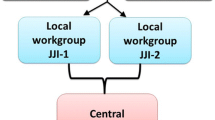Abstract
The present article reports on the use of a family-based parole initiative known as the Growing Up FAST program. The Growing Up FAST parole program targets serious youthful offenders released from juvenile correctional facilities and their families. A full description of this family-based initiative is given, and is augmented by a case example of one family's journey through the five levels of the Growing Up FAST parole program.
Similar content being viewed by others
References
Alexander, J. F., & Parsons, B. V. (1973). Short-term behavioral intervention with delinquent families: Impact on family process and recidivism. Journal of Abnormal Psychology, 81, 219–225.
Andrews, D. W., & Hickman, G. P. (1998). Family involvement in juvenile diversion and the prevention of problem behaviors. Family Science Review, 11, 259–276.
Bank, L., Marlowe, H., Reid, J. B., Patterson, G. R., & Weinrott, M. R. (1991). A comparative evaluation of parent-training interventions for families of chronic delinquents. Journal of Abnormal Child Psychology, 19, 15–33.
Bartle-Haring S. E., & Gavazzi, S. M. (1996) Multiple views on family data: The sample case of adolescent, maternal, and paternal perspectives on family differentiation levels. Family Process, 35, 457–472.
Barton, C., Alexander, J. F., Waldron, H., Turner, C. W., & Warburton, J. (1985). Generalizing treatment effects of functional family therapy: Three replications. The American Journal of Family Therapy, 13, 16–26.
Blumenkrantz, D. G., & Gavazzi, S. M. (1993). Guiding transitional events for children and adolescents through a modern day rite of passage. Journal of Primary Prevention, 13, 199–212.
Doherty, W. J. (1995). Boundaries between parent and family education and family therapy: The levels of family involvement model. Family Relations, 44, 353–358.
Gartland, H. J., & Day, H. D. (1991). Parental conflict and male adolescent problem behavior. The Journal of Genetic Psychology, 153, 201–209.
Gavazzi, S. M. (1991). The growing up FAST: Families and adolescents surviving and thrivingTM Program. Department of Family Relations and Human Development, The Ohio State University, Columbus, Ohio.
Gavazzi, S. M. (1995). The growing up FAST: Families and adolescents surviving and thrivingTM program. Journal of Adolescence, 18, 31–47.
Gavazzi, S. M., & Blumenkrantz, D. E. (1993). Facilitating clinical work with adolescents and their families through the rite of passage experience program. Journal of Family Psychotherapy, 4, 47–67.
Gavazzi, S. M., & Law, J. C. (1997). Creating definitions of successful adulthood for families with adolescents:Atherapeutic intervention from the growing upFAST program. American Journal of Family Psychotherapy, 8, 21–39.
Gavazzi, S. M., Rhine, E. E., & Partridge, C. R. (in press). Growing Up FAST and community supervision: Building bridges between parole officers and the families of serious juvenile offenders. Corrections Management Quarterly.
Gavazzi, S. M., Wasserman, D., Partridge, C., & Sheridan, S. (2000). The Growing Up FAST diversion program: Comparative treatment outcome. Aggression and Violent Behavior, 5, 159–175.
Gavazzi, S. M., Yarcheck, C., Wasserman, D., & Partridge, C. (2000). A balanced and restorative approach to juvenile crime: Programming for families of adolescent offenders. In G. L. Fox & M. L. Benson (Eds.), Contemporary Issues in Family Research Series (Families and CrimeMillennium Volume) (pp. 381–405). Stamford, CT: JAI Press.
Gordon, D. A., Arbuthnot, J., Gustafson, K. E., & McGreen, P. (1988). Home-based behavioral-systems family therapy with disadvantaged juvenile delinquents. The American Journal of Family Therapy, 16, 243–255.
Gordon, D. A., Graves, K., & Arbuthnot, J. (1995). The effect of functional family therapy for delinquents on adult criminal behavior. Criminal Justice and Behavior, 22, 60–73.
Henggeler, S. W. (1997). Treating serious antisocial behavior in youth: The MST approach. Juvenile Justice Bulletin, (May issue). Washington DC: Office of Juvenile Justice and Delinquency Prevention.
Henggeler, S. W. (1996). Treatment of violent juvenile offenders-we have the knowledge: Comment on Gorman-Smith et al. (1996) Journal of Family Psychology, 10, 137–141.
Henggeler, S. W., Borduin, C. M., Melton, G. B., Mann, B. J., Smith, L. A., Hall, J. A., Cone, L., & Fucci, B. R. (1991). Effects of multisystemic therapy on drug use and abuse in serious juvenile offenders: A progress report from two outcome studies. Family Dynamics of Addiction Quarterly, 1, 40–51.
Kumpfer, K. L. (1994). Family strengthening in preventing delinquency. Washington, DC: U.S. Department of Justice, Office of Juvenile Justice and Delinquency Prevention.
Larzelere, R. E., & Patterson, G. R. (1990). Parental management: Mediator of the effect of socioeconomic status on early delinquency. Criminology, 28, 301–324.
Law, J. C., & Gavazzi, S. M. (1999). Definitions of adulthood: From the voices of parents and adolescents. Family Science Review, 11, 318–335.
LeBlanc, M. (1992). Family dynamics, adolescent delinquency, and adult criminality. Psychiatry: Interpersonal & Biological Processes, 55, 336-353.
Loeber, R., Farrington, D.P., Stouthamer-Loeber, M., & Van Kammen, W.B. (1998). Antisocial behavior and mental health problems: Explanatory factors in childhood and adolescence. Mahwah, NJ: Lawrence Erlbaum.
Patterson, G. R., Reid, J. B., & Dishion, T. J. (1992). Antisocial boys. Eugene, OR: Castalia Press.
Quinn, W. H., Bell, K., & Ward, J. (1997). Family solutions for juvenile offenders. Prevention Researcher, 4, 10–12.
Rankin J. H., & Kern, R. (1994). Parental attachments and delinquency. Criminology, 32, 495–515.
Simons, R. L., Robertson, J. F., & Downs, W. R. (1989). The nature of the association between parental rejection and delinquent behavior. Journal of Youth and Adolescence, 18, 297–310.
Wasserman, D., Gavazzi, S. M., & Randall, A. P. (1998). Furthering preventionintervention linkages in family strengthening programs: The creation of a follow-up phase for the Growing Up FASTTM program. Family Science Review, 11, 300–317.
Author information
Authors and Affiliations
Rights and permissions
About this article
Cite this article
Partridge, C.R., Gavazzi, S.M. & Rhine, E.E. Working with the Families of Serious Juvenile Offenders: The Growing Up Fast Parole Program. Contemporary Family Therapy 23, 403–417 (2001). https://doi.org/10.1023/A:1013048927972
Issue Date:
DOI: https://doi.org/10.1023/A:1013048927972




